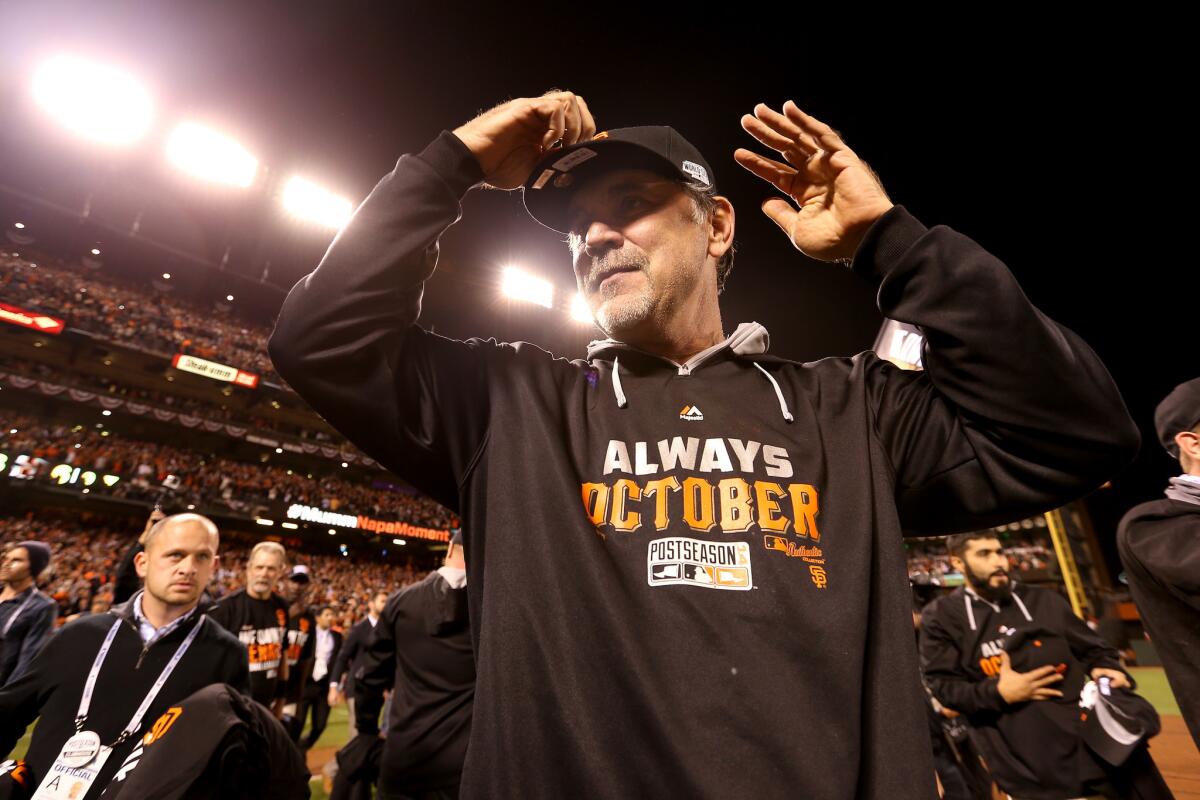Giants’ blueprint for success isn’t easily deciphered

- Share via
Reporting from SAN FRANCISCO — The Kansas City Royals might have skipped the World Series for three decades, but they have an identity now. Ladies and gentlemen, the Royals Way: a lockdown bullpen, suffocating defense and speed to kill.
The Oakland Athletics have a way, the zig-when-others-zag philosophy labeled and unfortunately caricatured as “Moneyball.” The Atlanta Braves had a way in their heyday: Maddux, Glavine and Smoltz. The Tampa Bay Rays have enough of a way — disciplined spending and analytics-based roster management — that the Dodgers handed the keys to their kingdom to Andrew Friedman, the guy that ran the Rays.
The object of the game is to win the World Series. Neither the Rays nor the Moneyball A’s have won the World Series. The Braves won once, despite a run of 14 consecutive division championships.
The San Francisco Giants could win the World Series for the third time in five years. In an industry in which success breeds copycats, opposing clubs should be rushing to imitate the Giants Way. But that might be easier said than done, since even the Giants themselves cannot distill their way into an easily understandable template.
“I don’t know if you can replicate it,” said pitcher Javier Lopez, one of the constants on all three World Series rosters.
There has been no raid on the Giants’ braintrust. Bobby Evans, the assistant general manager, said he never has been interviewed by a club searching for a general manager. Ron Wotus, the bench coach, said he has interviewed for five managerial vacancies and gone 0 for 5.
“Maybe, because our style is not so predictable, it might turn some people off,” Lopez said. “There’s no one thing that we do. I don’t know if we have that one particular philosophy or equation that makes us win.”
Said Wotus: “There’s no cookie-cutter plan here that we’re following that makes a difference.”
If anyone could explain the Giants’ plan, it would be Brian Sabean, the general manager. So, Brian, what exactly is the Giants Way?
“That’s a tough question to answer,” Sabean said. “Things develop over time.”
The Giants keep the braintrust together over time. Sabean, the longest-tenured general manager in baseball, has been in his position since 1997. Evans has been in the organization since 1994. So has Dick Tidrow, Sabean’s ace talent evaluator.
Three coaches — Wotus, Dave Righetti and Mark Gardner — predated the 2007 arrival of Manager Bruce Bochy.
In addition to what Sabean called that “continuity,” he said the Giants have come to understand that pitching wins — true everywhere, perhaps, but especially so in AT&T Park, and in a division that includes pitchers’ parks in Los Angeles and San Diego.
“You can’t rely on the long ball,” he said.
The Giants tried, at the behest of ownership, until Barry Bonds secured the all-time home run record in 2007. Then they pushed out Bonds and spread the wealth that was his salary.
They are not one of the industry’s darlings in scouting and player development, but their entire infield is home grown — catcher Buster Posey, first baseman Brandon Belt, second baseman Joe Panik, shortstop Brandon Crawford and third baseman Pablo Sandoval — and pitchers Madison Bumgarner, Matt Cain and Tim Lincecum all were first-round draft picks.
Bumgarner will start Game 1 of the World Series.
They are not afraid to trade prospects, even for rental players; Jake Peavy will start Game 2. They sign complementary pieces in major league free agency (Game 3 starter Tim Hudson, relievers Jeremy Affeldt and Santiago Casilla, and outfielder Michael Morse) and in minor league free agency (Game 4 starter Ryan Vogelsong, outfielder Gregor Blanco and Travis Ishikawa, the first-baseman-turned-outfielder who hit the home run that sent the Giants to the World Series).
They tend to retain their free agents — Lincecum, second baseman Marco Scutaro and outfielder Hunter Pence — but they are not shy about moving on, particularly from position players. Posey and Sandoval are the only position players still in the lineup from the 2010 World Series.
And, because no player received more than $20 million in salary this season, the Giants had the organization and financial depth to survive the postseason absence of four of the seven highest-paid players on their opening-day roster — Cain, Scutaro and outfielder Angel Pagan because of injury and Lincecum because of ineffectiveness.
So why do the Giants win? It is difficult even for them to say so, at least in terms of a game plan.
“I don’t think it’s as simple as the Atlanta Braves, where they had that starting pitching intact for a long period of time,” Wotus said. “For a while, we did, with Lincecum, Cain and Bumgarner, but guys have been filtered in and guys have been filtered out.”
Posey offered the standard trinity of pitching, defense and timely hitting. If the Giants had anything special up their sleeves, he either didn’t know or wouldn’t say.
“Is there a Giants Way?” Posey said. “We just try to win, any way we can.”
Four wins from three rings in five years, the Giants Way seems to be working, whatever it is.
More to Read
Go beyond the scoreboard
Get the latest on L.A.'s teams in the daily Sports Report newsletter.
You may occasionally receive promotional content from the Los Angeles Times.











